2017 LEXUS RC300H warning
[x] Cancel search: warningPage 488 of 640

4887-3. Do-it-yourself maintenance
RC300h_EE(OM24740E)
■When to replace your vehicle’s tires
Tires should be replaced if:
●The treadwear indicators are showing on a tire.
●You have tire damage such as cuts, splits, cracks deep enough to expose the fabric, and
bulges indicating internal damage
●A tire goes flat repeatedly or cannot be prop erly repaired due to the size or location of a cut or other damage
If you are not sure, consult any authorized Lexus dealer or repairer, or another duly qual- ified and equipped professional.
■Replacing tires and wheels
If the ID code of the tire pressure warning valve and transmitter is not registered, the tire pressure warning system will not work proper ly. After driving for about 10 minutes, the tire pressure warning light blinks for 1 minu te and stays on to indicate a system malfunc-
tion.
■Tire life
Any tire over 6 years old must be checked by a qualified technician even if it has seldom
or never been used or damage is not obvious.
■Routine tire inflation pressure checks
The tire pressure warning system does not re place routine tire inflation pressure checks.
Make sure to check tire inflation pressure as part of your routine of daily vehicle checks.
■When rotating the tires
Make sure that the power switch is off. If the tires are rotated while the power switch is in
ON mode, the tire position information will not be updated. If this accidentally occurs, either turn the power switch to off and then to ON mode, orinitialize the system after checking that the tire pressure is properly adjusted.
■Low profile tires
Generally, low profile tires will wear more ra pidly and tire grip performance will be reduced on snowy and/or icy roads when comp ared to standard tires. Be sure to use
snow tires or tire chains on snowy and/or icy roads and drive carefully at a speed appro- priate for road and weather conditions.
■If the tread on snow tires wears down below 4 mm (0.16 in.)
The effectiveness of the tires as snow tires is lost.
Page 489 of 640

4897-3. Do-it-yourself maintenance
7
Maintenance and care
RC300h_EE(OM24740E)
■Situations in which the tire pressure warning system may not operate properly
●In the following cases, the tire pressure warning system may not operate properly.
• If non-genuine Lexus wheels are used.
• A tire has been replaced with a tire that is not an OE (Original Equipment) tire. • A tire has been replaced with a tire that is not of the specified size.• Tire chains etc. are equipped.
• An auxiliary-supported run-flat tire is equipped. • If a window tint that affects the radio wave signals is installed.• If there is a lot of snow or ice on the vehi cle, particularly around the wheels or wheel
housings. • If the tire inflation pressure is extr emely higher than the specified level. • If tires not equipped with tire pressure warning valves and transmitters are used.
• If the ID code on the tire pressure warning valves and transmitters is not registered in the tire pressure warning computer.
●Performance may be affected in the following situations.
• Near a TV tower, electric power plant, gas station, radio station, large display, air- port or other facility that generates st rong radio waves or electrical noise
• When carrying a portable radio, cellular phone, cordless phone or other wireless communication deviceIf tire position information is not correctly displayed due to the radio wave conditions,
the display may be corrected by driving and changing the radio wave conditions.
●When the vehicle is parked, the time taken for the warning to start or go off could be extended.
●When tire inflation pressure declines rapi dly for example when a tire has burst, the warning may not function.
■The initialization operation
●Make sure to carry out initialization af ter adjusting the tire inflation pressure. Also, make sure the tires are cold before carry ing out initialization or tire inflation pres-
sure adjustment.
●If you have accidentally turned the power switch off during initialization, it is not neces- sary to press the reset switch again as init ialization will restart automatically when the
power switch has been turned to ON mode for the next time.
●If you accidentally press the reset switch when initialization is not necessary, adjust the tire inflation pressure to the specified leve l when the tires are cold, and conduct initial-
ization again.
■Warning performance of the tire pressure warning system
The warning of the tire pressure warning syst em will change in accordance with the con-
ditions under which it was initialized. For this reason, the system may give a warning even if the tire pressure does not reach a low enough level, or if the pressure is higher than the pressure that was adjusted to when the system was initialized.
Page 490 of 640
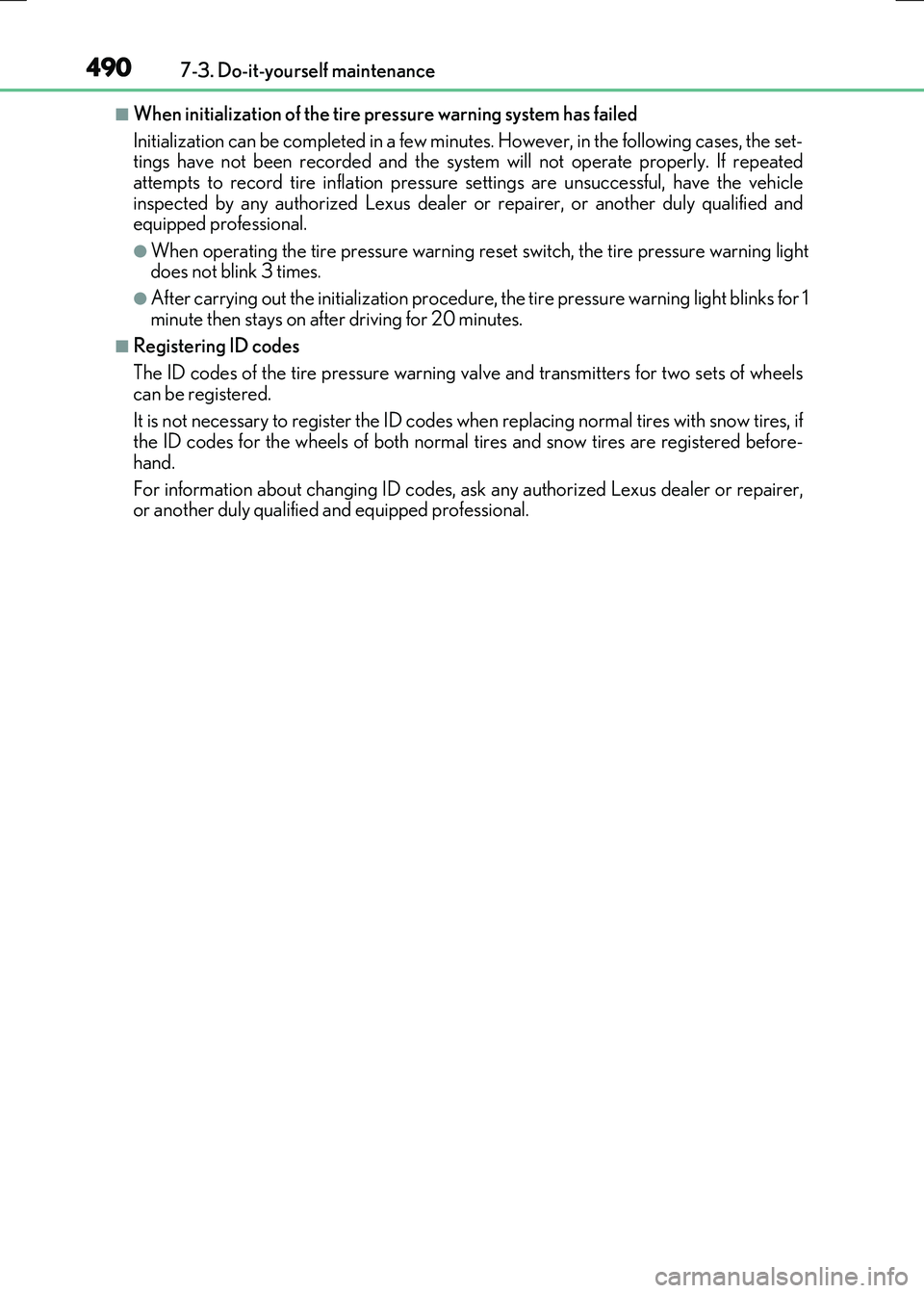
4907-3. Do-it-yourself maintenance
RC300h_EE(OM24740E)
■When initialization of the tire pressure warning system has failed
Initialization can be co mpleted in a few minutes. However, in the following cases, the set- tings have not been recorded and the syst em will not operate properly. If repeated
attempts to record tire inflation pressure settings are unsuccessful, have the vehicle inspected by any authorized Lexus dealer or repairer, or another duly qualified and equipped professional.
●When operating the tire pressure warning re set switch, the tire pressure warning light does not blink 3 times.
●After carrying out the initializat ion procedure, the tire pressure warning light blinks for 1
minute then stays on after driving for 20 minutes.
■Registering ID codes
The ID codes of the tire pressure warning valve and transmitters for two sets of wheels
can be registered.
It is not necessary to register the ID codes wh en replacing normal tires with snow tires, if the ID codes for the wheels of both normal tires and snow tires are registered before-
hand.
For information about changing ID codes, as k any authorized Lexus dealer or repairer, or another duly qualified and equipped professional.
Page 491 of 640
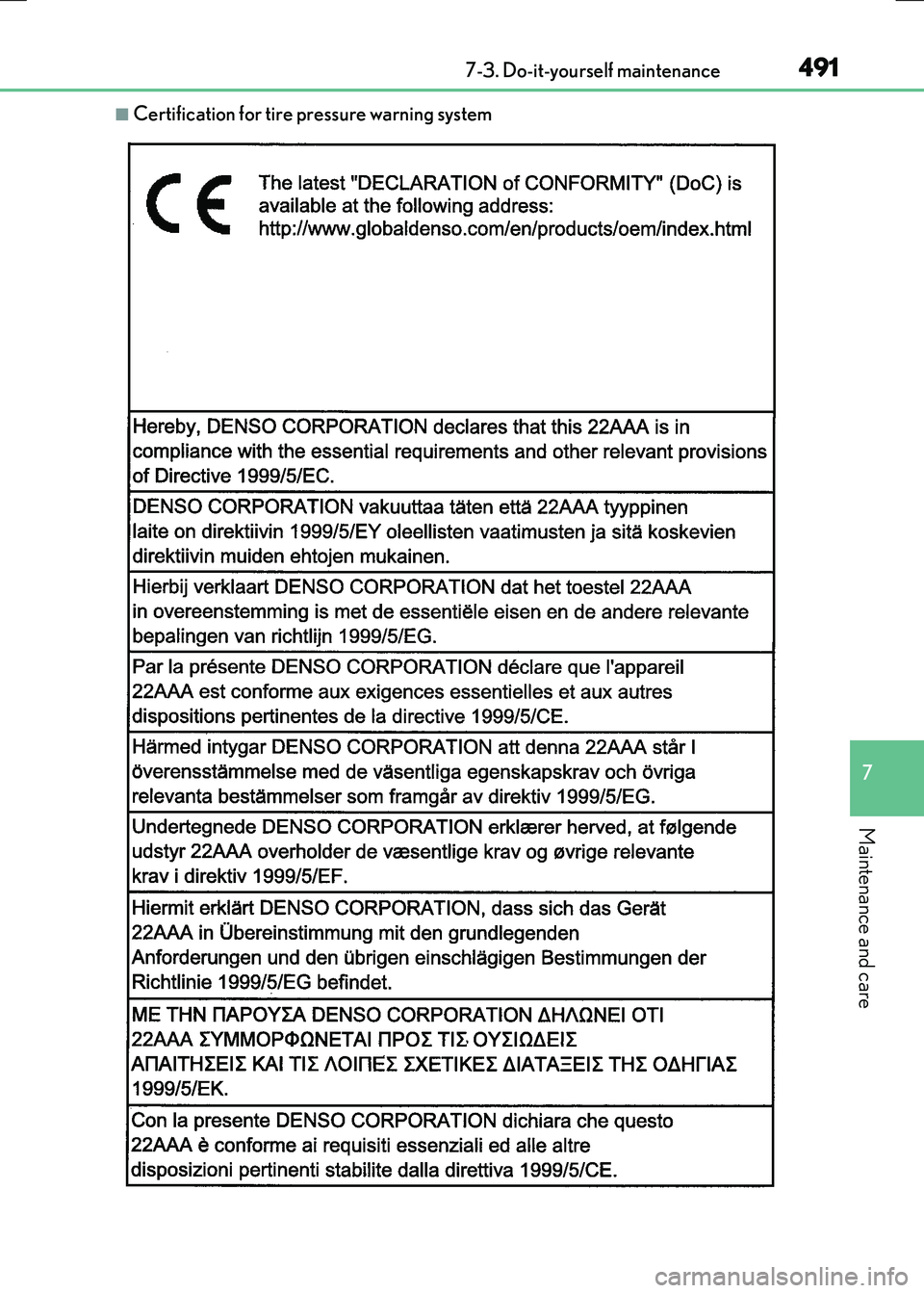
4917-3. Do-it-yourself maintenance
7
Maintenance and care
RC300h_EE(OM24740E)
■Certification for tire pressure warning system
Page 497 of 640
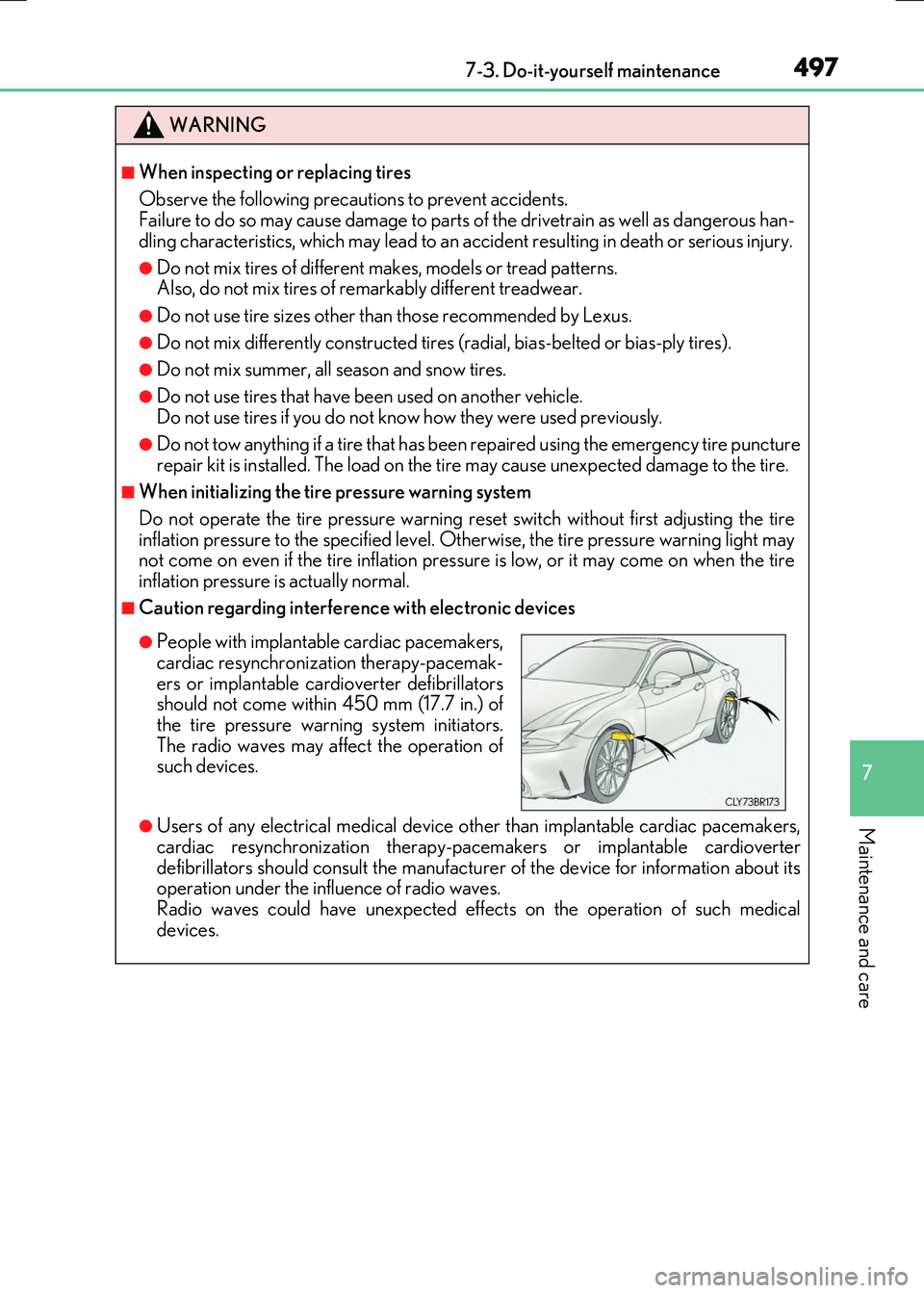
4977-3. Do-it-yourself maintenance
7
Maintenance and care
RC300h_EE(OM24740E)
WARNING
■When inspecting or replacing tires
Observe the following precautions to prevent accidents. Failure to do so may cause damage to parts of the drivetrain as well as dangerous han-
dling characteristics, which may lead to an acc ident resulting in death or serious injury.
●Do not mix tires of different makes, models or tread patterns. Also, do not mix tires of remarkably different treadwear.
●Do not use tire sizes other th an those recommended by Lexus.
●Do not mix differently constructed tires (radial, bias-belted or bias-ply tires).
●Do not mix summer, all season and snow tires.
●Do not use tires that have been used on another vehicle. Do not use tires if you do not know how they were used previously.
●Do not tow anything if a tire that has been repaired using the emergency tire puncture
repair kit is installed. The load on the tire may cause unexpected damage to the tire.
■When initializing the tire pressure warning system
Do not operate the tire pressure warning re set switch without first adjusting the tire
inflation pressure to the specified level. Ot herwise, the tire pressure warning light may not come on even if the tire inflation pressu re is low, or it may come on when the tire inflation pressure is actually normal.
■Caution regarding interference with electronic devices
●Users of any electrical medical device other than implantable cardiac pacemakers,
cardiac resynchronization therapy-pacemakers or implantable cardioverter defibrillators should consult the manufacturer of the device for information about itsoperation under the influence of radio waves.
Radio waves could have unexpected effects on the operation of such medical devices.
●People with implantable cardiac pacemakers,
cardiac resynchronization therapy-pacemak- ers or implantable cardioverter defibrillatorsshould not come within 450 mm (17.7 in.) of
the tire pressure warning system initiators. The radio waves may affect the operation ofsuch devices.
Page 498 of 640
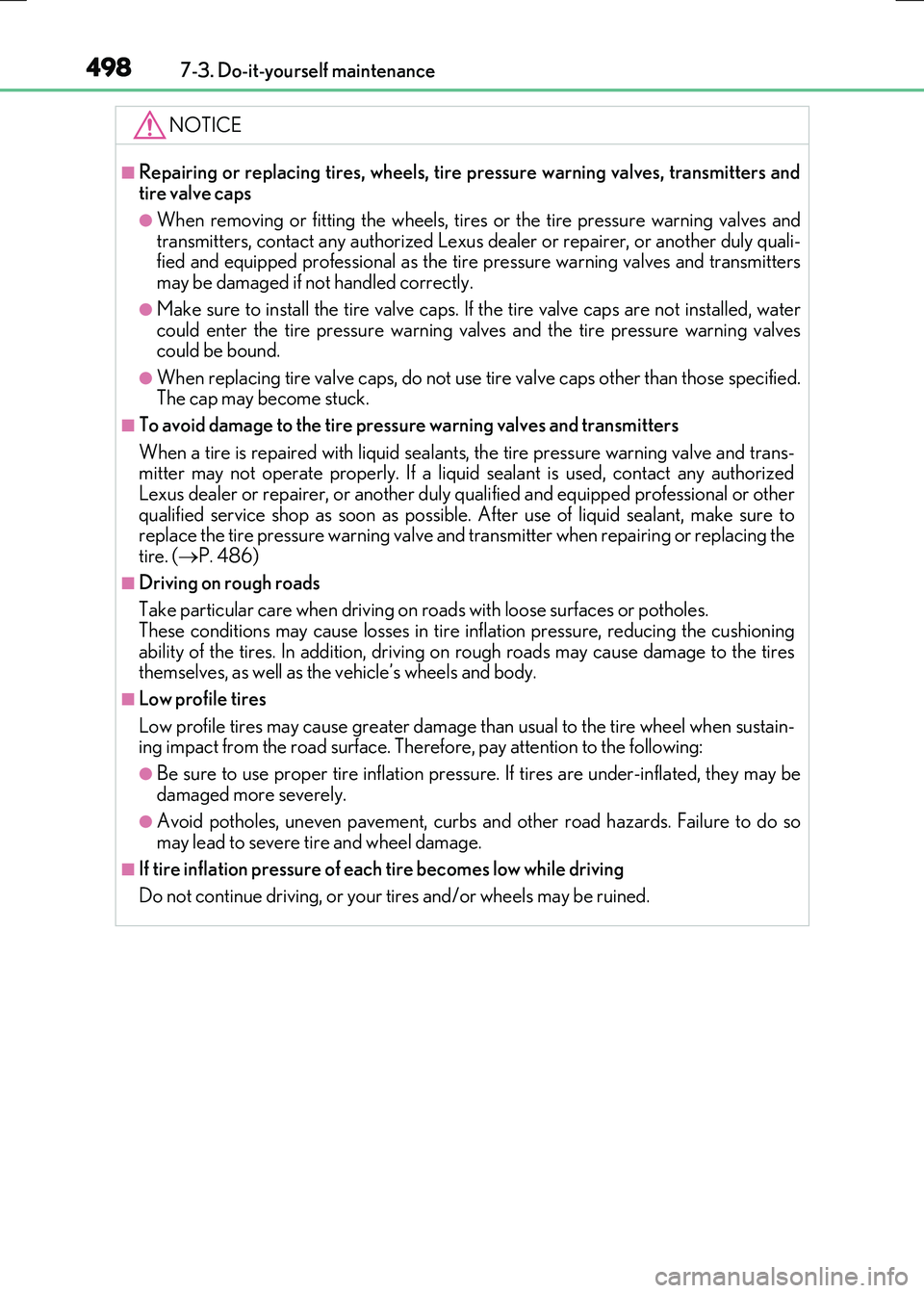
4987-3. Do-it-yourself maintenance
RC300h_EE(OM24740E)
NOTICE
■Repairing or replacing tires, wheels, tire pressure warning valves, transmitters and tire valve caps
●When removing or fitting the wheels, tires or the tire pressure warning valves and
transmitters, contact any authorized Lexus de aler or repairer, or another duly quali- fied and equipped professional as the tire pressure warning valves and transmitters may be damaged if not handled correctly.
●Make sure to install the tire valve caps. If the tire valve caps are not installed, water could enter the tire pressure warning valv es and the tire pressure warning valves could be bound.
●When replacing tire valve caps, do not use tire valve caps other than those specified.The cap may become stuck.
■To avoid damage to the tire pressure warning valves and transmitters
When a tire is repaired with liquid sealants, the tire pressure warning valve and trans- mitter may not operate properly. If a liquid sealant is used, contact any authorizedLexus dealer or repairer, or another duly qu alified and equipped professional or other
qualified service shop as soon as possible. After use of liquid sealant, make sure to replace the tire pressure warning valve and transmitter when repairing or replacing the tire. ( P. 486)
■Driving on rough roads
Take particular care when driving on roads with loose surfaces or potholes. These conditions may cause losses in tire inflation pressure, reducing the cushioning
ability of the tires. In addition, driving on rough roads may cause damage to the tires themselves, as well as the vehicle’s wheels and body.
■Low profile tires
Low profile tires may cause greater damage than usual to the tire wheel when sustain- ing impact from the road surface. Therefore, pay attention to the following:
●Be sure to use proper tire inflation pressu re. If tires are under-inflated, they may be
damaged more severely.
●Avoid potholes, uneven pavement, curbs an d other road hazards. Failure to do so may lead to severe tire and wheel damage.
■If tire inflation pressure of ea ch tire becomes low while driving
Do not continue driving, or your tires and/or wheels may be ruined.
Page 500 of 640
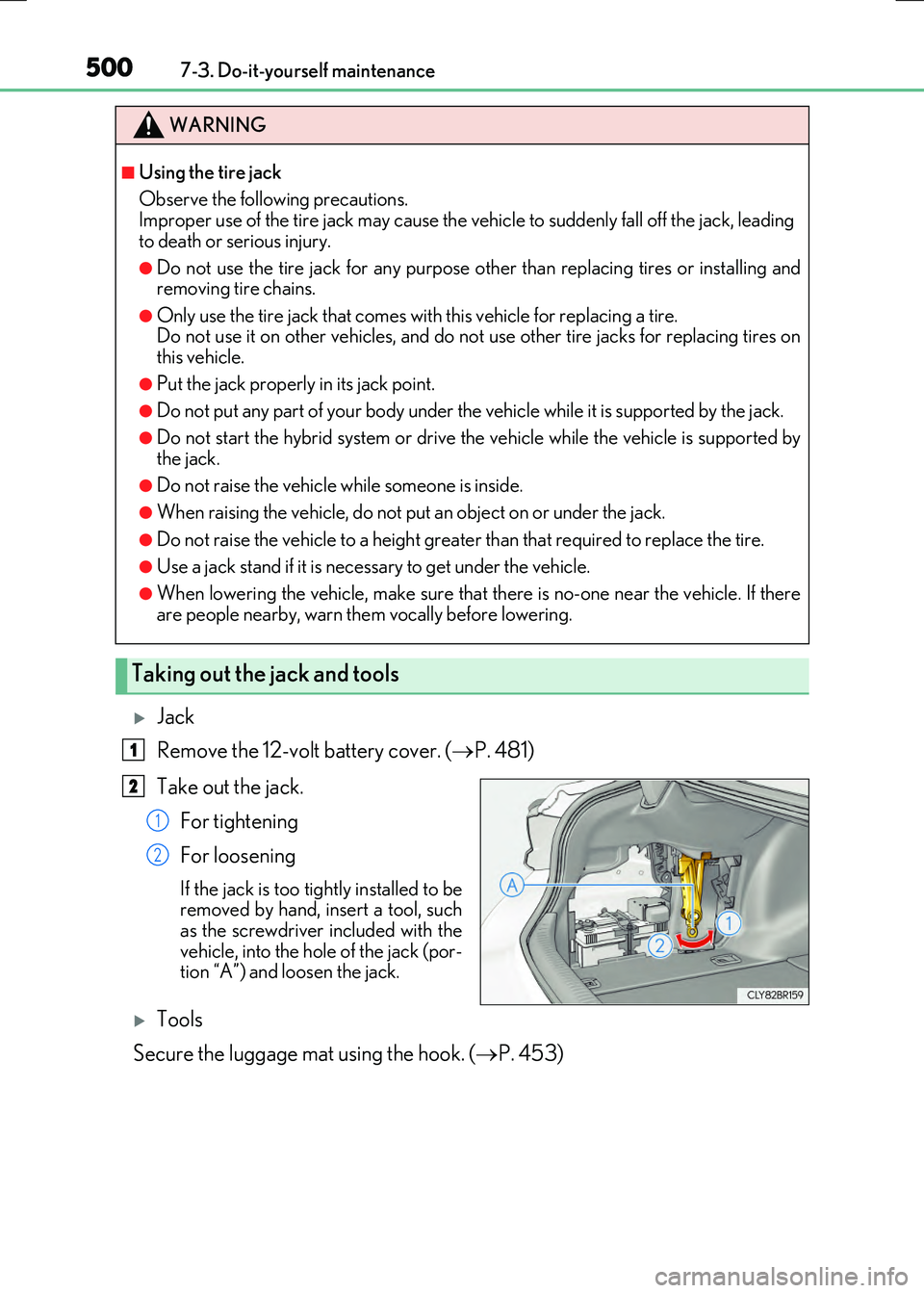
5007-3. Do-it-yourself maintenance
RC300h_EE(OM24740E)
Jack
Remove the 12-volt battery cover. ( P. 481)
Take out the jack.
For tightening
For loosening
If the jack is too tightly installed to be removed by hand, insert a tool, suchas the screwdriver included with the
vehicle, into the hole of the jack (por- tion “A”) and loosen the jack.
Tools
Secure the luggage mat using the hook. ( P. 453)
WARNING
■Using the tire jack
Observe the following precautions. Improper use of the tire jack may cause the vehicle to suddenly fall off the jack, leading
to death or serious injury.
●Do not use the tire jack for any purpose ot her than replacing tires or installing and removing tire chains.
●Only use the tire jack that comes with this vehicle for replacing a tire. Do not use it on other vehicles, and do no t use other tire jacks for replacing tires on this vehicle.
●Put the jack properly in its jack point.
●Do not put any part of your body under the vehicle while it is supported by the jack.
●Do not start the hybrid system or drive the vehicle while the vehicle is supported by
the jack.
●Do not raise the vehicle while someone is inside.
●When raising the vehicle, do not put an object on or under the jack.
●Do not raise the vehicle to a height greater than that required to replace the tire.
●Use a jack stand if it is necessary to get under the vehicle.
●When lowering the vehicle, make sure that there is no-one near the vehicle. If there
are people nearby, warn them vocally before lowering.
Taking out the jack and tools
1
2
1
2
Page 502 of 640

5027-3. Do-it-yourself maintenance
RC300h_EE(OM24740E)
Raise the vehicle until the tire is
slightly raised off the ground.
Remove all the wheel nuts and the
tire.
When resting the tire on the ground,
place the tire so that the wheel design faces up to avoid scratching the wheelsurface.
4
5
WARNING
■Replacing a flat tire
●Do not touch the disc wheels or the area around the brakes immediately after thevehicle has been driven.
After the vehicle has been driven the disc wheels and the area around the brakes will be extremely hot. Touching these areas wi th hands, feet or other body parts while changing a tire, etc. may result in burns.
●Failure to follow these precautions could cause the wheel nuts to loosen and the tireto fall off, resulting in death or serious injury.
• Never use oil or grease on the wheel bolts or wheel nuts.
Oil and grease may cause the wheel nuts to be excessively tightened, leading to bolt or disc wheel damage. In addition, the oil or grease can cause the wheel nuts to loosen and the wheel may fall off, causing a serious accident. Remove any oil or
grease from the wheel bolts or wheel nuts. • Have the wheel nuts tightened with a torque wrench to 103 N•m (10.5 kgf•m,76 ft•lbf) as soon as possible after changing wheels.
• Do not attach a heavily damaged wheel or nament, as it may fly off the wheel while the vehicle is moving.• When installing a tire, only use wheel nuts that have been specifically designed for
that wheel. • If there are any cracks or deformations in the bolt screws, nut threads or bolt holesof the wheel, have the vehicle inspected by any authorized Lexus dealer or
repairer, or another duly qualif ied and equipped professional.